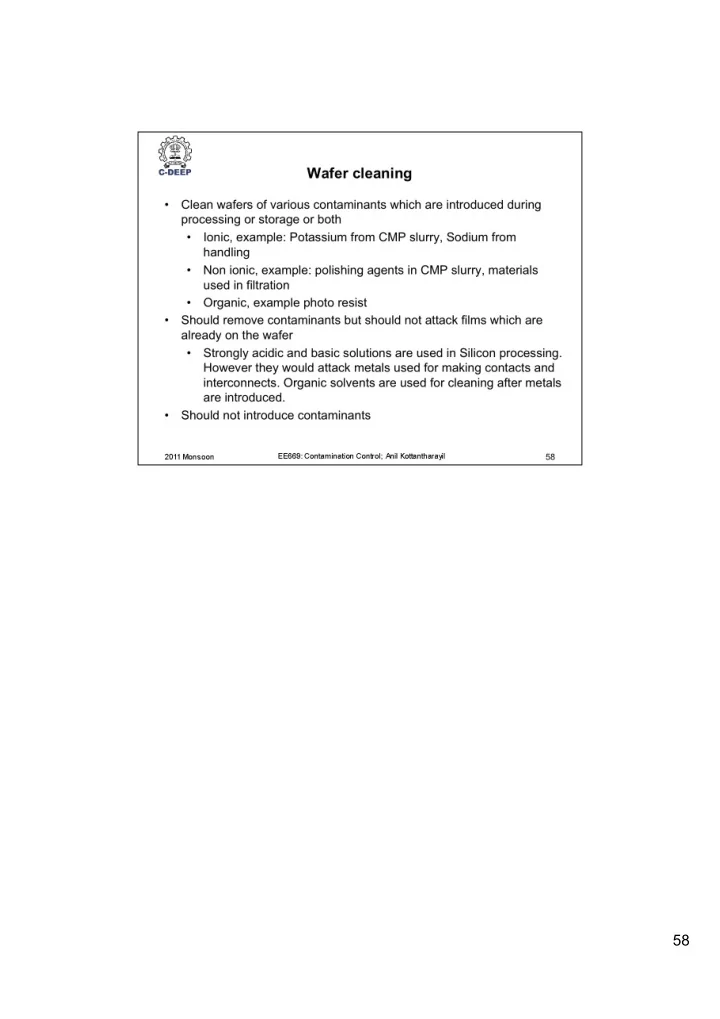

58
59
The ionic contamination requirements can be calculated as follows: Water would have ~ 3e22 molecules per cc. Out of this, approximately 5e13 per cc are ionized at room temperature. Pure water at room temperature would have resistivity of 18.4 M Ω .cm. If the ionic contaminants should not influence the resistivity, their concentration should be significantly less than 5e13 per cc, i.e. < 5e13/3e22 ~ 1.6 ppb. 60
61
Oxygen and carbon oxides dissolve easily in water. 62
63
The purity requirements depends on the application. SiH $ shown in this example is used for epitaxial growth of Si and is required to be of the highest quality. In several applications like high voltage applications etc, silane can be further purified at the point of use. Note the last row of the table. The resistivity refers to the desired resistivity of the epitaxial film deposited using this gas. On the other hand CF 4 is typically used for reactive ion etching of Silicon, silicon oxide and silicon nitride. Usually photoresist is used as an etch mask. i.e. the process is carried out in the presence of organic contaminants (resist). So the wafer must be cleaned after the etch to remove the resist. More over the etch process is unlikely to introduce contaminants into the wafer as it is carried out at room temperature or near room temperature in otherwise clean processing conditions. So the CF 4 need not be as clean. 64
Step 1: mixture is also called piranha clean or SPM (sulphuric peroxide mixture). The mixture is highly reactive. H 2 O 2 in addition to being a strong oxidizer, also scrub the wafers as it decomposes to water and oxygen. Oxygen released would form bubbles and scrub the wafer surface. Since H2O2 is unstable, usually the mixture with the rest of the chemicals is prepared and heated to the desired temperature. Subsequently H2O2 is added to the solution. Organics are oxidized to form CO 2 and soluble products. A thin layer of SiO x is formed during this process step. This mixture is also used for resist strip after dry etching processes. Step 2: The chemical oxide formed in the previous step is etched in this mixture. 49% HF is mixed with DI water. Step 3: DI water rinse removes any HF remaining on the wafer surface. Step 4: This solution essentially strips organics, metals and particles. The mixture is prepared as described in step 1. NH 4 OH alone would etch Si. This can cause roughness on the surface of the wafer. So if sufficient amount of H 2 O 2 is not used or if the H 2 O 2 is partly decomposed, the cleaning step may leave the surface rough. For this reason, some times smaller amounts of NH 4 OH is used. The cleaning step is also called standard clean - 1 or SC-1 or APM (ammonia peroxide mixture). This step is also used for removal of resists after dry etch processes. Step 5: DI water rinse removes any chemicals from the previous step remaining on the wafer surface. Step 6: This solution strips alkali ions. The preparation of the solution is as described in step 1. The cleaning step is also called standard clean 2 or SC-2. Step 7: DI water rinse to remove any chemicals from the previous step. Typically this step is the last step. The DI water rinse is typically continued till the resistivity of the water in the batch reaches ~ 18 65 M Ω .cm. The steps leaves a chemical oxide, SiO x on the surface. Step 8: This step is optional and leaves the surface passivated with Si-H bonds.
The theory can be understood by oxidation/reduction reactions. When a species is oxidized, it losses electrons to the oxidant. So an oxidant would accept electrons. On the other hand when a species is reduced, the species gains electrons from the reductant. The reductant losses electrons. For example, in the first reaction, the forward reaction result in loss of electrons from the Mn. Mn is the reductant. In the reverse reaction, Mn 2+ gains electrons and hence it is the oxidant. The redox potential as represented is useful for comparing the direction of reactions. If the reactions are listed in the high to low redox potential as shown, the reaction with the highest redox potential is likely to proceed in the forward direction (oxidation) in the presence of any other reaction with a smaller redox potential. The smaller redox potential reaction would proceed in the reverse direction (reduction). It may be noted that the H 2 O 2 /H 2 O reaction would proceed in the reverse direction by accepting electrons resulting from any of the reactions above it proceeding in the forward direction. Most of these reactions involve the conversion of metallic species into metallic ions which would dissolve in water. It must be noted that the O 3 /O 2 reaction has a smaller redox potential than the peroxide reaction. This means that ozone could be more effective for cleaning. Such a reaction offers several advantages: O 3 can be generated relatively cheaply in the lab, whereas H 2 O 2 decomposes on storage and is expensive. An example of an improved process using O 3 is developed by IMEC, Belgium. Details can be found in: M. M. Heyns et al., Cost-effective cleaning and high-quality thin gate oxides, IBM journal of research and development, vol. 43, No. 3, May 1999, pp. 339. IMEC clean completely eliminates NH 4 OH and hence surface roughening is much lower. 66
67
68
D = D 0 when T is infinite. kT = 0.1 at 927 C 69
70
Recommend
More recommend